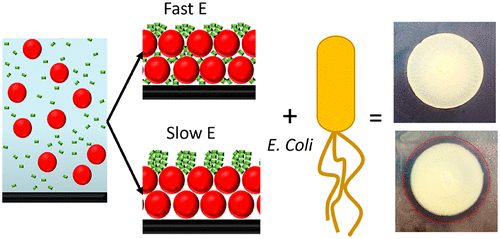当前位置:
X-MOL 学术
›
ACS Appl. Polym. Mater.
›
论文详情
Our official English website, www.x-mol.net, welcomes your
feedback! (Note: you will need to create a separate account there.)
Zinc Oxide Superstructures in Colloidal Polymer Nanocomposite Films: Enhanced Antibacterial Activity through Slow Drying
ACS Applied Polymer Materials ( IF 4.4 ) Pub Date : 2020-01-21 , DOI: 10.1021/acsapm.9b00991 Yichen Dong 1 , Maialen Argaiz 2 , Boshen He 1 , Radmila Tomovska 2, 3 , Tao Sun 4 , Ignacio Martín-Fabiani 1
ACS Applied Polymer Materials ( IF 4.4 ) Pub Date : 2020-01-21 , DOI: 10.1021/acsapm.9b00991 Yichen Dong 1 , Maialen Argaiz 2 , Boshen He 1 , Radmila Tomovska 2, 3 , Tao Sun 4 , Ignacio Martín-Fabiani 1
Affiliation

|
Achieving control over the distribution of biocides across the thickness of polymer nanocomposite films is one of the largest challenges to develop efficient antibacterial surfaces. In such applications, it is key to maximize the biocide presence at the film top surface to ensure contact with bacteria. Here, we make use of evaporation driven colloidal self-assembly to control the vertical distribution of biocides in polymer composite films cast from colloidal blends of polymer and zinc oxide (ZnO) nanoparticles. We present a thorough study which shows that the evaporation rate and ZnO volume fraction have a strong impact on the final film architecture and on its wetting and antibacterial properties. For high enough ZnO volume fraction, the ZnO nanoparticles assemble in superstructures on top of the film, which are higher the slower the evaporation rate used, and maximum ZnO surface coverage achieved through slow film drying. At high ZnO volume fraction (ϕ = 0.29), the zone of inhibition diameter against Escherichia coli increases as evaporation rate decreases, with the nanocomposite films having the strongest antibacterial activity when formed at slow evaporation rate. We propose a model for the formation of these colloidal superstructures based on the segregation of large (polymer) and small (ZnO) particles during drying, followed by the assembly of small particles around packed large particles due to differences in the surface charge of the two populations. Our work provides valuable guidelines for the design and assembly of not only antibacterial colloidal films but also a wider range of functional colloidal polymer films including abrasion resistant, self-cleaning, and others.
中文翻译:

胶体聚合物纳米复合薄膜中的氧化锌超结构:通过缓慢干燥增强的抗菌活性
实现对杀菌剂在聚合物纳米复合薄膜整个厚度上的分布的控制是开发有效抗菌表面的最大挑战之一。在这样的应用中,关键是最大限度地提高膜顶表面的杀菌剂存在,以确保与细菌接触。在这里,我们利用蒸发驱动的胶体自组装来控制杀菌剂在由聚合物和氧化锌(ZnO)纳米粒子的胶体共混物制成的聚合物复合膜中的垂直分布。我们提供了一项详尽的研究,该研究表明蒸发速率和ZnO体积分数对最终的膜结构及其润湿和抗菌性能有很大影响。为了获得足够高的ZnO体积分数,ZnO纳米颗粒会以超结构组装在薄膜顶部,蒸发速度越慢,通过缓慢的薄膜干燥就可以实现最大的ZnO表面覆盖率。在高ZnO体积分数(ϕ = 0.29)时,抑制直径区域大肠杆菌随着蒸发速率的降低而增加,当以缓慢的蒸发速率形成时,纳米复合膜具有最强的抗菌活性。我们提出了一种基于干燥过程中大颗粒(聚合物)和小颗粒(ZnO)的偏析的胶体超结构形成模型,然后由于二者的表面电荷差异而将小颗粒组装在堆积的大颗粒周围人口。我们的工作不仅为抗菌胶体薄膜的设计和组装提供了宝贵的指导,还为包括抗磨,自清洁等在内的更广泛的功能性胶体聚合物薄膜的设计和组装提供了宝贵的指导。
更新日期:2020-01-22
中文翻译:

胶体聚合物纳米复合薄膜中的氧化锌超结构:通过缓慢干燥增强的抗菌活性
实现对杀菌剂在聚合物纳米复合薄膜整个厚度上的分布的控制是开发有效抗菌表面的最大挑战之一。在这样的应用中,关键是最大限度地提高膜顶表面的杀菌剂存在,以确保与细菌接触。在这里,我们利用蒸发驱动的胶体自组装来控制杀菌剂在由聚合物和氧化锌(ZnO)纳米粒子的胶体共混物制成的聚合物复合膜中的垂直分布。我们提供了一项详尽的研究,该研究表明蒸发速率和ZnO体积分数对最终的膜结构及其润湿和抗菌性能有很大影响。为了获得足够高的ZnO体积分数,ZnO纳米颗粒会以超结构组装在薄膜顶部,蒸发速度越慢,通过缓慢的薄膜干燥就可以实现最大的ZnO表面覆盖率。在高ZnO体积分数(ϕ = 0.29)时,抑制直径区域大肠杆菌随着蒸发速率的降低而增加,当以缓慢的蒸发速率形成时,纳米复合膜具有最强的抗菌活性。我们提出了一种基于干燥过程中大颗粒(聚合物)和小颗粒(ZnO)的偏析的胶体超结构形成模型,然后由于二者的表面电荷差异而将小颗粒组装在堆积的大颗粒周围人口。我们的工作不仅为抗菌胶体薄膜的设计和组装提供了宝贵的指导,还为包括抗磨,自清洁等在内的更广泛的功能性胶体聚合物薄膜的设计和组装提供了宝贵的指导。











































 京公网安备 11010802027423号
京公网安备 11010802027423号